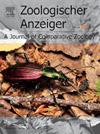阿根廷中部放线虫的分类、分子系统发育及分布(蜘蛛目:放线虫科)
IF 1.5
3区 生物学
Q2 ZOOLOGY
引用次数: 0
摘要
放线虫包括98种新向性地区特有的活板门蜘蛛。在阿根廷布宜诺斯艾利斯西南部,记录到4种:木麻黄放线菌Ríos-Tamayo and Goloboff, 2018, A. laventana Miglio, psamrez - miles &;Bonaldo, 2020;巴塔哥尼亚放线虫Ríos-Tamayo和Goloboff, 2018; puelche放线虫Ríos-Tamayo和Goloboff, 2018;A. puelche的雌性未知。通过对布宜诺斯艾利斯省西南部Bahía布兰卡地区放线虫的检查,我们发现了不属于任何已知物种的标本。因此,我们采用了分子和形态学证据相结合的方法来描述、诊断和说明放线虫,并首次描述了A. puelche的雌性。我们还报道了巴塔哥尼亚和普埃尔切的新分布记录。雄斑竹的跗骨和跖骨呈红色,鳞茎龙骨和突突发育良好,下侧龙骨上无齿;雌性,可以通过精子来区分,双裂,外叶发育良好,内部基部突出。雌花可以通过有一个带有轻微裂片的精囊来区分。利用最大似然法进行的第一次分子系统发育研究表明,放线虫是单系的,粗骨棘虫是一个独立的分支,而粗骨棘虫虽然与粗骨棘虫同属,但与剩余的阿根廷种关系更密切。本文章由计算机程序翻译,如有差异,请以英文原文为准。
Taxonomy, molecular phylogeny and distribution of Actinopus Perty, 1833 (Araneae: Actinopodidae) in central Argentina
Actinopus comprises 98 species of trapdoor spiders endemic to the Neotropic region. In southwestern Buenos Aires, Argentina, four species are recorded: Actinopus casuhati Ríos-Tamayo and Goloboff, 2018, A. laventana Miglio, Pérez-Miles & Bonaldo, 2020, Actinopus patagonia Ríos-Tamayo and Goloboff, 2018, and Actinopus puelche Ríos-Tamayo and Goloboff, 2018; females of A. puelche are unknown. By the examination of Actinopus from Bahía Blanca district, southwestern Buenos Aires province, we found specimens that do not fit within any of the known species. Thus, we implemented an integrative approach combining molecular and morphological evidence to describe, diagnose and illustrate Actinopus obrerografico sp. nov. In addition, we describe for the first time the female of A. puelche. We also present new distributional records for A. patagonia and A. puelche. Males of A. obrerografico sp. nov. Can be distinguished by having red tarsi and metatarsi, and bulb with well developed keels and apophysis, and no denticles along the inferior prolateral keel; females, can be distinguished by the spermathecae, bilobed with external lobe well developed and an internal basal proejection. Females of A. puelche can be distinguished by having a spermathecae with slight marked lobes. A first molecular phylogeny using Maximum likelihood yielded Actinopus as monophyletic, A. obrerografico sp. nov. as a distinct clade and A. puelche more related to the remaining Argentinean species despite living in sympatry with A. obrerografico sp. nov.
求助全文
通过发布文献求助,成功后即可免费获取论文全文。
去求助
来源期刊

Zoologischer Anzeiger
生物-动物学
CiteScore
2.80
自引率
7.10%
发文量
75
审稿时长
>12 weeks
期刊介绍:
Zoologischer Anzeiger - A Journal of Comparative Zoology is devoted to comparative zoology with a special emphasis on morphology, systematics, biogeography, and evolutionary biology targeting all metazoans, both modern and extinct. We also consider taxonomic submissions addressing a broader systematic and/or evolutionary context. The overall aim of the journal is to contribute to our understanding of the organismic world from an evolutionary perspective.
The journal Zoologischer Anzeiger invites suggestions for special issues. Interested parties may contact one of the editors.
 求助内容:
求助内容: 应助结果提醒方式:
应助结果提醒方式:


